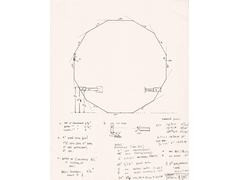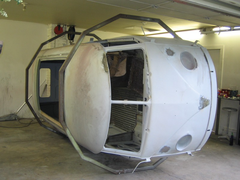chrsgrain
|
| posted on 21/1/15 at 04:40 AM |

|
|
Help needed with 2D ?CAD drawing...
Hi all,
New project awaits! I'm restoring a '68 VW pick up, and want to make a 'rotisserie' to be able to roll it over (picture below)
and I've found some plans, but they are in inches and I want to change the dimensions a bit to suit my garage, while maintaining the angles and
concept.
I've downloaded a free CAD program to do it (QCAD) but I can't make head or tail of it! I was hoping someone could make it in to sensible
metric sizes for me to give to my metal merchant, and even better some way of me making the circle bigger and smaller, which would give me the lengths
of material for those diameters, if that makes sense....
Here are the instructions to go with the figure..."Cut your 0.23622047 decimal inch wall thickness 2" x 2" tubing @ 15 degree cuts
to length. Mark all lengths, 21 inches and 23 inches. (Please see foot note). Pair the correct to plans sections in two, double check and make minor
adjustments if needed. Break the rotisserie into a top and bottom, each should share parallels angles and one side. Using Jig, weld pairs, then weld
pairs together. Now you have a complete multigon making a 360 degree circle, I.E. 12 30 degree angles make 360 degree multigon. Repeat this step for
second multigon. "
 
metal_circle
 
rollingvw
Cheers
Chris
Spoing! - the sound of an irony meter breaking...
|
|
|
|
|
blakep82
|
| posted on 21/1/15 at 06:19 AM |

|
|
Theres 25.4mm in an inch, so quickest way is to multiply inches by 25.4 to give you mm.
21 inch x 25.4 = 533.4mm (53.34cm)
For the fractions, say 6 3/4, 3÷4 = 0.75, so 6.75
No cad needed, just a calculator
[Edited on 21/1/15 by blakep82]
________________________
IVA manual link http://www.businesslink.gov.uk/bdotg/action/detail?type=RESOURCES&itemId=1081997083
don't write OT on a new thread title, you're creating the topic, everything you write is very much ON topic!
|
|
|
MP3C
|
| posted on 21/1/15 at 09:36 AM |

|
|
I know in AutoCAD you can produce the drawing in imperial and then convert the drawing to metric and put the measurements on it.
Matt
|
|
|
mcerd1
|
| posted on 21/1/15 at 09:38 AM |

|
|
Any decent steel stockholder should be able to get them bent to whatever radius you need (most likely as half or ¼ circles)
That would save you alot of working out 
But if you need it segmented (I assume it's meant to rest on the flat sides so that you don't need to wedge it) the its fairly easy to
workout with trig. CAD is even easier though  so just tell me the inside or outside diameter and the tube size you want to use and the number of
segments so just tell me the inside or outside diameter and the tube size you want to use and the number of
segments
[Edited on 21/1/2015 by mcerd1]
-
|
|
|
mcerd1
|
| posted on 21/1/15 at 09:40 AM |

|
|
quote:
Originally posted by MP3C
I know in AutoCAD you can produce the drawing in imperial and then convert the drawing to metric and put the measurements on it.
Matt
or model it in inches then scale the whole model by 25.4* in any cad package
-
|
|
|
Smoking Frog
|
| posted on 21/1/15 at 10:12 AM |

|
|
A 12 sided circle (dodecagon) is a nice easy shape to understand.
Each angle is 30 degrees (360 divided by 12).
Each cut would be 15 degrees (30 divided by 2)
To work out the length of each side, multiply diameter by Pi and divide by 12.
So if diameter = 2500mm
2500 x 3.14159 ÷ 12 = 654.5mm
|
|
|
gremlin1234
|
| posted on 21/1/15 at 11:40 AM |

|
|
quote:
Originally posted by chrsgrain
Cut your 0.23622047 decimal inch wall thickness 2" x 2" tubing @ 15 degree cuts to length. Mark all lengths, 21 inches and 23 inches.
magically 0.23622047 inches is exactly 6mm!
|
|
|













